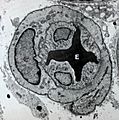Blood vessel facts for kids
A blood vessel is like a tiny tube that carries blood all around your body. These tubes are a super important part of your circulatory system. Blood vessels that carry blood away from your heart are called arteries. The ones that bring blood back to your heart are called veins. Tiny, tiny vessels called capillaries connect arteries and veins. They deliver blood to all your body's tissues.
Your heart and all your blood vessels work together as your circulatory system. Your heart pumps blood, and the vessels carry it. This blood delivers oxygen to every part of your body.
Sometimes, blood vessels need to get wider. This is called vasodilation. It helps your body cool down by releasing heat. The word vas- comes from Latin and means "vessel" or "container." Other times, blood vessels need to get narrower. This is called vasoconstriction. It helps your body keep warm by stopping heat from escaping.
Did you know an adult human body has about 100,000 kilometers (60,000 miles) of blood vessels? That's enough to go around the Earth more than twice! When your body grows new blood vessels, it's called angiogenesis.
Contents
How Blood Vessels Are Built
Blood vessels are not all the same. Different parts of your body need different kinds of vessels for their jobs. Each blood vessel wall has three main layers:
The Three Layers of a Blood Vessel
- Inner Layer: This layer is very smooth. It helps blood flow easily without sticking.
- Middle Layer: This layer has strong, stretchy muscle fibers. These muscles can squeeze or relax to make the vessel wider or narrower. This helps control blood flow and blood pressure.
- Outer Layer: This layer is made of strong, flexible tissue. It helps protect the blood vessel and holds it in place. It also contains tiny blood vessels and nerves that supply the vessel itself.
How Layers Change
The way a blood vessel's wall is built depends on its job and how much blood pressure it handles. For example:
- Arteries close to your heart need to be very stretchy. This is because they deal with high blood pressure from the heart's strong pumps.
- As blood vessels get further from the heart, they get smaller. Their walls have more muscle. These muscles help push the blood along into the tiny capillaries.
Images for kids
See also
 In Spanish: Vaso sanguíneo para niños
In Spanish: Vaso sanguíneo para niños




